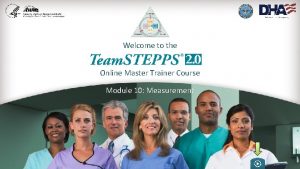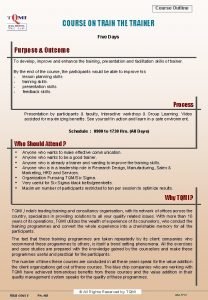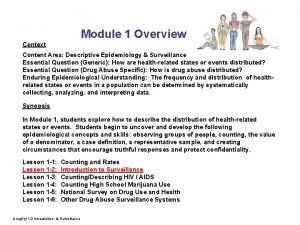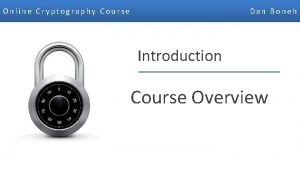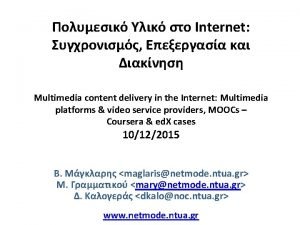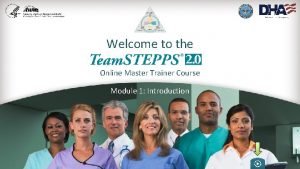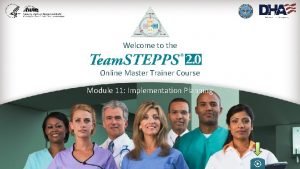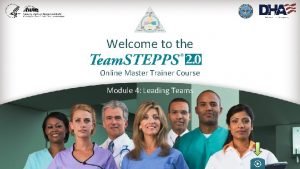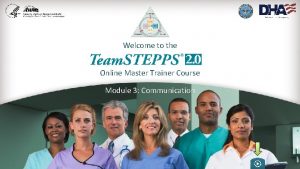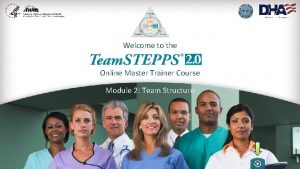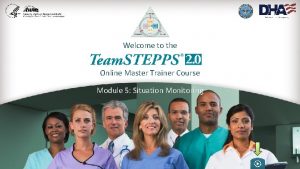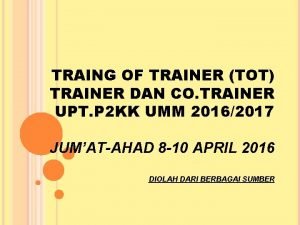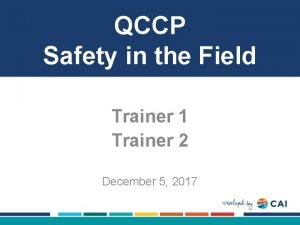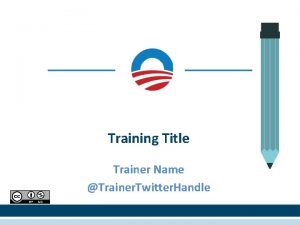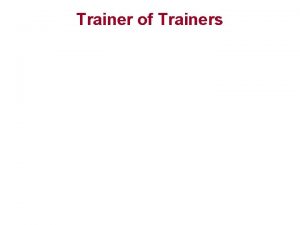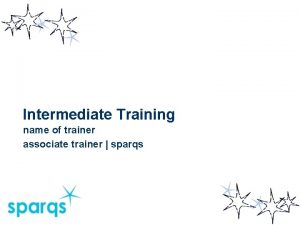Welcome to the Online Master Trainer Course Module













































- Slides: 45

Welcome to the Online Master Trainer Course Module 6: Mutual Support

How This Online Course Works This online course will walk you through the Team. STEPPS content just as you will present it when you train your colleagues and staff It teaches you all the concepts that comprise the Team. STEPPS initiative While also teaching you to teach Team. STEPPS to your colleagues Use the navigation buttons in the lower right to work through the online modules Select here to move back to the previous slide Module 6: Mutual Support Select here to move to the next slide 2 of 45

The Materials You Will Use When you deliver your training you will use these materials: • Instructor Manual – Course Management Guide – Instructor guides – Course slides – Measurement tools • Customizable materials • Videos Module 6: Mutual Support Select here to review materials on the Team. STEPPS website 3 of 45

Please Print the Instructor Guide To best use this online module, please print the Module 6 Instructor Guide, located here Read pages 3 -4 in the guide before we begin Then we will proceed to work through the slides you will use to train – just as if you are delivering this module at your facility. Module 6: Mutual Support 4 of 45

Slide 2: Objectives You will use slide 2 to introduce the objectives for this module See page 5 in the Instructor Guide for details on how to facilitate this slide Module 6: Mutual Support 5 of 45

The Team. STEPPS Framework So far, we have covered: • • Team Structure Communication Leadership Situation Monitoring In this module, we will cover Mutual Support Module 6: Mutual Support 6 of 45

Slide 3: Mutual Support: • Dependent upon information gathered through situation monitoring • Is moderated by communication • Enhanced by leaders who encourage and role model mutual support behaviors Module 6: Mutual Support 7 of 45

Mutual Support Mutual support involves members: • Assisting each other • Providing and receiving feedback • Exerting assertive and advocacy behaviors when patient safety is threatened Take 5 minutes and ask yourself: “When I think of mutual support, I think of…” Module 6: Mutual Support 8 of 45

Slide 4: Mutual Support What did you think of for “mutual support”? When you teach, use a flipchart to discuss the question: What types of behavior do you think make up mutual support? Facilitate the discussion to include the potential answers on page 7 of the Instructors Guide Module 6: Mutual Support 9 of 45

The Three Mutual Support Strategies In this module we will present three strategies you can use to foster Mutual Support: • Task Assistance • Feedback • Advocacy & Assertion Module 6: Mutual Support 10 of 45

Task Assistance (Slide 5) Team members foster a climate in which it is expected that assistance will be actively sought and offered as a method for reducing the occurrence of error. Module 6: Mutual Support 11 of 45

Task Assistance Factors that influence task assistance include: • The type of situation • Attitudes and beliefs • Style of communication Module 6: Mutual Support 12 of 45

Task Assistance Solves A Problem In regard to task assistance, remember to: • Communicate clear and specific availability of time and skills • Foster a climate supportive of task assistance • Use common courtesy when asking for help • Close the loop on task communication • Account for experience level when asking for help Module 6: Mutual Support 13 of 45

Slide 6: Task Assistance Example Two members of the GI Laboratory are assessing an elderly patient who has just had conscious sedation for a colonoscopy. The monitor shows SVT at a rate of 150 and a BP of 76/48. The nurse calls out the vital signs while the physician continues to monitor the rhythm. A nurse passing by the room hears the call-out. Take 5 minutes to consider these two questions: • How would you offer task assistance in this example? • How would you request task assistance in this example? Module 6: Mutual Support 14 of 45

What is Feedback? (Slide 7) Feedback is information provided for the purpose of improving team performance Ways feedback benefits the team: • Fostering improvement in work performance • Meeting the need for growth • Promoting better working relationships • Helping the team set goals for ongoing improvement Module 6: Mutual Support 15 of 45

Types of Feedback (Slide 8) Formal • Retrospective and typically scheduled in advance • Has an evaluative quality • Examples: Collaborative discussions, case conferences, individual performance reviews Informal • Typically in real time Take five minutes to think about a time when you provided or received feedback. Was the feedback helpful? • Provided on an ongoing basis • Focuses on knowledge and practical skills development • Examples: Huddles, debriefs Module 6: Mutual Support 16 of 45

Characteristics of Effective Feedback (Slide 9) Effective feedback is: • Timely • Respectful • Specific • Directed toward improvement • Helps prevent the same problem from occurring in the future • Considerate See Instructor Guide, page 13 Module 6: Mutual Support 17 of 45

Slide 10: Providing Effective Feedback Video Let’s view a video example of providing effective feedback After you view the video, please return to the this browser window to continue this module Select the image to launch a web browser where you can watch the video Module 6: Mutual Support 18 of 45

Providing Effective Feedback: Video Discussion What was effective in the feedback provided? • Timely • Respectful and related to behavior • Specific • Directed • Considerate Why would it be a good practice to share the experience with other team members? Module 6: Mutual Support 19 of 45

Feedback Exercise (Slide 11) Consider this scenario: An attending physician watches an intern start to place a chest tube in an obese patient in an incorrect location. Take 10 minutes to write down how you would provide feedback in this scenario After you have written out your answers, select the Forward button to continue Module 6: Mutual Support 20 of 45

Feedback Exercise Discussion Example response: The attending physician corrects the placement of the planned incision by pulling the intern aside, showing the intern the landmarks to use, and demonstrating how the patient’s position on the table is slightly distorting the anatomy. When you teach, be sure to analyze the responses of your learners for all the aspects of effective feedback See Instructor Guide, page 15 Module 6: Mutual Support 21 of 45

Advocacy and Assertion Advocate for the patient • Invoked when team members’ viewpoints don’t coincide with that of a decision maker Assert a corrective action in a firm and respectful manner Module 6: Mutual Support 22 of 45

Advocacy and Assertion Tools Three Tools: • The Assertive Statement • The Two-Challenge Rule • Using CUS Words Module 6: Mutual Support 23 of 45

The Assertive Statement (Slide 13) Respectful and supportive of authority Clearly asserts concerns and suggestions Is nonthreatening and ensures that critical information is addressed Five-Step Process: 1. Open the discussion 2. State the concern 3. State the problem—real or perceived 4. Offer a solution 5. Obtain an agreement Module 6: Mutual Support 24 of 45

Assertive Statement Example You’re in the endoscopy suite, and a patient is undergoing a colonoscopy. As the endoscopy nurse, you think you see a possible lesion that was missed. What should the nurse say in this situation? Take 10 minutes to write out exactly what you would say Module 6: Mutual Support 25 of 45

Assertive Statement Example Discussion Five-Step Process: 1. Open the discussion 2. State the concern 3. State the problem—real or perceived 4. Offer a solution 5. Obtain an agreement Refer to page 18 in the Instructor Guide for information on facilitating this discussion Module 6: Mutual Support 26 of 45

The Two-Challenge Rule (Slide 14) Challenge colleagues if you have requested clarification, but the response does not alleviate the concern The goal is to create a teamwork culture where team members respectfully challenge one another when the plan is unclear Module 6: Mutual Support 27 of 45

Two-Challenge Rule (Slide 15) Invoked when an initial assertion is ignored… • It is your responsibility to assertively voice your concern at least two times to ensure that it has been heard • The member being challenged must acknowledge • If the outcome is still not acceptable: • Take a stronger course of action • Use supervisor or chain of command Module 6: Mutual Support 28 of 45

Two-Challenge Rule (Slide 16) Empower any team member to “stop the line” if he or she senses or discovers a breach of safety This is an action never to be taken lightly, but it requires immediate cessation of the process and resolution of the safety issue When you teach, ask your learners to share a situation in which they used or could have used the Two-Challenge Rule See Instructor Guide, page 21 Module 6: Mutual Support 29 of 45

Please Use CUS Words (Slide 17) “CUS” signal phrases catch the listener’s attention To use CUS: Module 6: Mutual Support 30 of 45

CUS Example Video Let’s view a video example of using CUS words After you view the video, please return to the this browser window to continue this module Select the image to launch a web browser where you can watch the video Module 6: Mutual Support 31 of 45

CUS Example: Video Discussion How was the “challenge” presented to the doctor? Did she state that she was: • Concerned • Uncomfortable • Safety Issue See Instructor Guide, page 22 Module 6: Mutual Support 32 of 45

Advocacy and Assertion Scenario (Slide 18) A medical floor nurse is assigned to a patient following a myocardial infarction. The attending physician provides the final treatment, reviews the clinical situation, and determines that the patient is well enough to be discharged. Before the patient is discharged, the nurse checks the patient’s vitals one last time. The nurse finds it unusual that the blood pressure and heart rate are substantially elevated. Please take 10 minutes to write out what you would do to address the problem Module 6: Mutual Support 33 of 45

Advocacy and Assertion Scenario Discussion What would you do to address the problem? Would you use: • The Assertive Statement • The Two-Challenge Rule • CUS words See Instructor Guide, page 23 Module 6: Mutual Support 34 of 45

Conflict in Teams (Slide 19) Informational Conflict (We have different information!) Module 6: Mutual Support Interpersonal Conflict (Hostile and harassing behavior) 35 of 45

Disruptive Behavior Disruptive behavior that should be actively discouraged: • Condescending language • Impatience with questions • Refusal to answer questions • Strong verbal abuse • Threatening body language • Physical abuse Module 6: Mutual Support Select here to visit the Department of Defense’s Professional Conduct Toolkit webpage 36 of 45

Tools to Address Conflict in Teams Informational Conflict (We have different information!) Two-Challenge Rule Module 6: Mutual Support Interpersonal Conflict (Hostile and harassing behavior) DESC Script 37 of 45

Conflict Resolution: DESC Script (Slide 20) A constructive approach for managing and resolving conflict: D—Describe the specific situation E—Express your concerns about the action S—Suggest other alternatives C—Consequences should be stated Module 6: Mutual Support 38 of 45

Let’s “DESC It!” (Slide 21) When using the DESC script: • Have timely discussion • Work on win-win • Frame in terms of your own experience • Choose a private location • Use “I” statements; avoid blaming • Critique is not criticism • Focus on what is right, not who is right Module 6: Mutual Support 39 of 45

A DESC Scenario (Slide 22) Consider this scenario: A nurse feels that a patient has abdominal distension and pain secondary to a distended bladder and needs a Foley catheter. The nurse receives the order from the resident on call. When the attending later realizes that the order was given without his consent, he raises his voice to the resident in front of staff and the patient. Take 10 minutes to write down how you would use the DESC script in this scenario Module 6: Mutual Support 40 of 45

A DESC Scenario (Slide 22) How did you use DESC? D - Describe the specific situation E - Express your concerns about the action S - Suggest other alternatives C - Consequences should be stated Module 6: Mutual Support 41 of 45

Tools & Strategies Summary BARRIERS • Inconsistency in Team Membership • Lack of Time • Lack of Information Sharing • Hierarchy • Defensiveness • Conventional Thinking • Complacency • Varying Communication Styles • Conflict • Lack of Coordination and Follow-up With Coworkers • Distractions • Fatigue • Workload • Misinterpretation of Cues • Lack of Role Clarity Module 6: Mutual Support TOOLS and STRATEGIES Communication • SBAR • Call-Out • Check-Back • Handoff Leading Teams • Brief • Huddle • Debrief Situation Monitoring • STEP • I’M SAFE Mutual Support • Task Assistance • Feedback • Assertive Statement • Two-Challenge Rule • CUS • DESC Script OUTCOMES n Shared Mental Model n Adaptability n Team Orientation n Mutual Trust n Team Performance n Patient Safety!! 42 of 45

Slide 24: Applying Team. STEPPS Exercise Take 15 minutes to answer these questions: • Is your teamwork issue related to mutual support? • If yes, what is the mutual support issue? • Which mutual support tools or strategies might you consider implementing to address the issue? Select here to download and print the Team. STEPPS Implementation Worksheet and answer the questions. Module 6: Mutual Support 43 of 45

Module 6 Summary In this module you learned to: • Describe how mutual support affects team processes and outcomes • Discuss specific strategies to foster mutual support (e. g. , task assistance, feedback) • Identify specific tools to facilitate mutual support • Describe conflict resolution strategies Module 6: Mutual Support 44 of 45

Module 6 Conclusion This concludes Module 6 of the Team. STEPPS 2. 0 Online Master Trainer Course Go to Module 7 Module 6: Mutual Support 45 of 45
 Teamstepps master trainer
Teamstepps master trainer Master trainer 45
Master trainer 45 Train the trainer course objectives
Train the trainer course objectives Train the trainer outline
Train the trainer outline C device module module 1
C device module module 1 Safety leadership for supervisors
Safety leadership for supervisors Course module sample
Course module sample Wise men three clever are we
Wise men three clever are we You are welcome my dear
You are welcome my dear Half brick wall
Half brick wall Course number and title
Course number and title Chaine parallèle muscle
Chaine parallèle muscle Welcome to our online class
Welcome to our online class Welcome access online
Welcome access online Welcome to my online class
Welcome to my online class Cryptography online course
Cryptography online course Supplemental online coursework
Supplemental online coursework Ipac core competencies occupational health and safety
Ipac core competencies occupational health and safety Online cryptography course
Online cryptography course Jrotc marksmanship instructor course online
Jrotc marksmanship instructor course online Ptit safe driving and awareness course
Ptit safe driving and awareness course Comlex level 1 question bank
Comlex level 1 question bank Medical english online course
Medical english online course Fmcsa north american standard level i course online
Fmcsa north american standard level i course online Jrotc marksmanship instructor course online
Jrotc marksmanship instructor course online Moocs
Moocs Chandler online academy
Chandler online academy American beauty online
American beauty online Hình ảnh bộ gõ cơ thể búng tay
Hình ảnh bộ gõ cơ thể búng tay Frameset trong html5
Frameset trong html5 Bổ thể
Bổ thể Tỉ lệ cơ thể trẻ em
Tỉ lệ cơ thể trẻ em Gấu đi như thế nào
Gấu đi như thế nào Chụp tư thế worms-breton
Chụp tư thế worms-breton Chúa sống lại
Chúa sống lại Các môn thể thao bắt đầu bằng tiếng nhảy
Các môn thể thao bắt đầu bằng tiếng nhảy Thế nào là hệ số cao nhất
Thế nào là hệ số cao nhất Các châu lục và đại dương trên thế giới
Các châu lục và đại dương trên thế giới Công thức tính độ biến thiên đông lượng
Công thức tính độ biến thiên đông lượng Trời xanh đây là của chúng ta thể thơ
Trời xanh đây là của chúng ta thể thơ Mật thư tọa độ 5x5
Mật thư tọa độ 5x5 Phép trừ bù
Phép trừ bù Phản ứng thế ankan
Phản ứng thế ankan Các châu lục và đại dương trên thế giới
Các châu lục và đại dương trên thế giới Thể thơ truyền thống
Thể thơ truyền thống Quá trình desamine hóa có thể tạo ra
Quá trình desamine hóa có thể tạo ra
